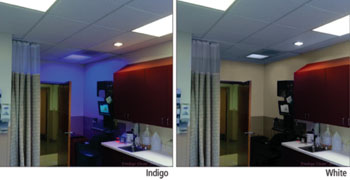Innovative Light Fixture Fights Healthcare Infections
By HospiMedica International staff writers
Posted on 13 Jul 2015
A new device uses visible light for environmental disinfection, inactivating a wide range of microorganisms that are known causes of hospital acquired infections (HAIs).Posted on 13 Jul 2015
Developed by researchers at the University of Strathclyde (United Kingdom), the Indigo-Clean uses a high-intensity narrow spectrum (HINS) of visible indigo-colored light which reflects off of walls and surfaces, penetrating harmful micro-organisms. The 405 nanometer band light targets porphyrins inside the bacteria, exciting them to produce reactive oxygen species (ROS) inside the cell, which inactivate the bacteria, preventing it from repopulating the space.

Image: Indigo-Clean lighting fixtures in both modes (Photo courtesy of Indigo-Clean).
The light can operate safely and continuously in the presence of humans, requires no operator, and kills bacteria in the air and on hard and soft surfaces. Three product configurations are available to balance cost, effectiveness, and visual preferences: blended white light, indigo-only, and a switchable white/indigo configuration. The Indigo-Clean lighting fixture is manufactured under license in North America by Kenall Manufacturing (Kenosha, WI, USA).
“As part of Strathclyde’s clinical engagement in the UK over the last seven years, this technology has proven effective in killing bacteria in hospital settings,” said Cliff Yahnke, director of clinical affairs at Kenall. “Breaking the chain of infection, from an infected patient, to the environment, to new patient, is vitally important, and the ability of this technology to be in use and effective at all times will make a huge difference.”
The 405 nm wavelength is not in fact blue, but appears to the eye as violet, a color for which a human eye has a very limited sensitivity. It is very close to 400 nm, the wavelength of ultraviolet (UV) light, bordering on the very extreme of human vision.
Related Links:
University of Strathclyde
Indigo-Clean
Kenall Manufacturing














